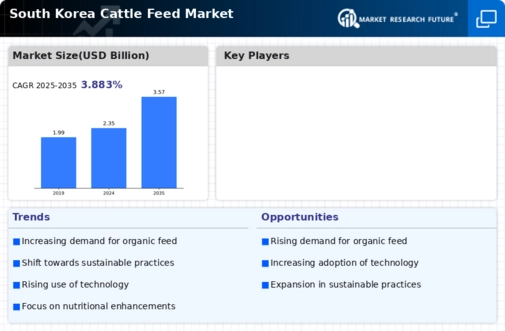Government Support and Subsidies
Government policies play a crucial role in shaping the cattle feed market in South Korea. The government has implemented various support programs and subsidies aimed at promoting the livestock sector, which includes the cattle feed industry. These initiatives often focus on enhancing feed quality, improving production efficiency, and ensuring food security. For instance, recent data suggests that government subsidies for cattle feed production have increased by 20% in the last fiscal year, encouraging farmers to adopt better feeding practices. This financial backing not only aids farmers in managing costs but also stimulates growth within the cattle feed market, as it allows for investment in advanced feed technologies and sustainable practices.
Rising Demand for High-Quality Beef
The cattle feed market in South Korea experiences a notable driver due to the increasing consumer demand for high-quality beef. As consumers become more health-conscious, they are willing to pay a premium for beef that is perceived as healthier and more nutritious. This trend compels cattle farmers to enhance the quality of their livestock, which in turn necessitates the use of superior cattle feed. Reports indicate that the demand for premium beef has surged by approximately 15% over the past year, prompting farmers to invest in better feed formulations. Consequently, this shift influences the cattle feed market, as producers seek to meet the evolving preferences of consumers, thereby driving innovation and quality improvements in feed products.
Shift Towards Local Feed Ingredients
The cattle feed market in South Korea is witnessing a shift towards the utilization of locally sourced feed ingredients. This trend is largely driven by the desire to reduce dependency on imported feed components, which can be subject to price volatility and supply chain disruptions. By focusing on local ingredients, farmers can not only support the domestic agricultural economy but also ensure fresher and potentially more nutritious feed for their cattle. Recent estimates suggest that the use of local feed ingredients has increased by 25% over the past two years, reflecting a growing commitment to sustainability and self-sufficiency within the cattle feed market. This shift may also lead to innovations in feed formulation, as producers explore new local sources.
Increasing Awareness of Animal Nutrition
The cattle feed market in South Korea is significantly influenced by the growing awareness of animal nutrition among farmers and livestock producers. As knowledge about the nutritional needs of cattle expands, there is a corresponding shift towards more scientifically formulated feed. This trend is driven by the recognition that proper nutrition directly impacts cattle health, growth rates, and overall productivity. Recent surveys indicate that approximately 70% of cattle farmers are now prioritizing nutritional content in their feed choices, leading to a rise in demand for specialized feed products. This heightened focus on nutrition is likely to propel the cattle feed market forward, as producers seek to optimize their feeding strategies to enhance livestock performance.
Technological Advancements in Feed Production
Technological advancements are emerging as a pivotal driver in the cattle feed market in South Korea. Innovations in feed production processes, such as precision feeding and the use of data analytics, are enabling farmers to optimize feed efficiency and reduce waste. These technologies allow for the customization of feed formulations based on specific nutritional requirements, which can enhance cattle growth and health. Recent reports indicate that the adoption of such technologies has led to a 10% increase in feed conversion rates among progressive farmers. As these advancements continue to evolve, they are likely to reshape the cattle feed market, fostering a more efficient and sustainable approach to livestock nutrition.

















Leave a Comment